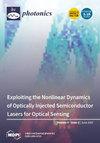车载日掩通量-傅里叶变换红外光谱仪数据预处理方法研究
IF 2.1
4区 物理与天体物理
Q2 OPTICS
引用次数: 0
摘要
车载太阳掩星通量-傅立叶变换红外光谱仪利用太阳作为红外光源,对大气中的分子吸收进行量化。它可用于污染物排放的快速三维监测和温室气体的柱浓度监测。该系统具有移动性强、可进行非接触测量和远距离测量等优点。然而,在车载应用中,车辆颠簸和障碍物会给测量光谱带来畸变,影响气体浓度反演结果和通量计算的准确性。本文提出了一种结合自组织映射神经网络和相关分析的光谱数据预处理方法,用于剔除太阳掩星通量-傅里叶变换红外光谱仪在移动观测过程中测量到的异常光谱数据。与传统方法相比,该方法无需事先调整比较阈值和获取训练光谱,具有自动更新权重的优点,无需设置固定的相关比较系数。模拟实验中所有异常模拟光谱的准确识别证明了该方法的有效性。在车载应用实验中,从 1739 个光谱数据点中成功筛选出 342 个异常光谱。实验结果表明,该方法可提高气体浓度测量结果的准确性,并可应用于车载太阳掩星通量-傅里叶变换红外光谱仪系统,以满足移动监测中大量光谱数据的预处理需求。本文章由计算机程序翻译,如有差异,请以英文原文为准。
Research on a Data Preprocessing Method for a Vehicle-Mounted Solar Occultation Flux–Fourier Transform Infrared Spectrometer
A vehicle-mounted solar occultation flux–Fourier transform infrared spectrometer uses the sun as an infrared light source to quantify molecular absorption in the atmosphere. It can be used for the rapid three-dimensional monitoring of pollutant emissions and the column concentration monitoring of greenhouse gases. The system has the advantages of high mobility and a capacity for noncontact measurement and measurement over long distances. However, in vehicle-mounted applications, vehicle bumps and obstacles introduce aberrations in the measured spectra, affecting the accuracy of gas concentration inversion results and flux calculations. In this paper, we propose a spectral data preprocessing method that combines a self-organizing mapping neural network and correlation analysis to reject anomalous spectral data measured by the solar occultation flux–Fourier transform infrared spectrometer during mobile observations. Compared to the traditional method, this method does not need to adjust the comparison threshold and obtain the training spectra in advance and has the advantage of automatically updating the weights without the need to set fixed correlation comparison coefficients. The accurate identification of all anomalous simulated spectra in the simulation experiments proved the effectiveness of the method. In the vehicle-mounted application experiment, 342 anomalous spectra were successfully screened from 1739 spectral data points. The experimental results show that the method can improve the accuracy of gas concentration measurement results and can be applied to a vehicle-mounted solar occultation flux–Fourier transform infrared spectrometer system to meet the preprocessing needs of a high number of spectral data in mobile monitoring.
求助全文
通过发布文献求助,成功后即可免费获取论文全文。
去求助
来源期刊

Photonics
Physics and Astronomy-Instrumentation
CiteScore
2.60
自引率
20.80%
发文量
817
审稿时长
8 weeks
期刊介绍:
Photonics (ISSN 2304-6732) aims at a fast turn around time for peer-reviewing manuscripts and producing accepted articles. The online-only and open access nature of the journal will allow for a speedy and wide circulation of your research as well as review articles. We aim at establishing Photonics as a leading venue for publishing high impact fundamental research but also applications of optics and photonics. The journal particularly welcomes both theoretical (simulation) and experimental research. Our aim is to encourage scientists to publish their experimental and theoretical results in as much detail as possible. There is no restriction on the length of the papers. The full experimental details must be provided so that the results can be reproduced. Electronic files and software regarding the full details of the calculation and experimental procedure, if unable to be published in a normal way, can be deposited as supplementary material.
 求助内容:
求助内容: 应助结果提醒方式:
应助结果提醒方式:


